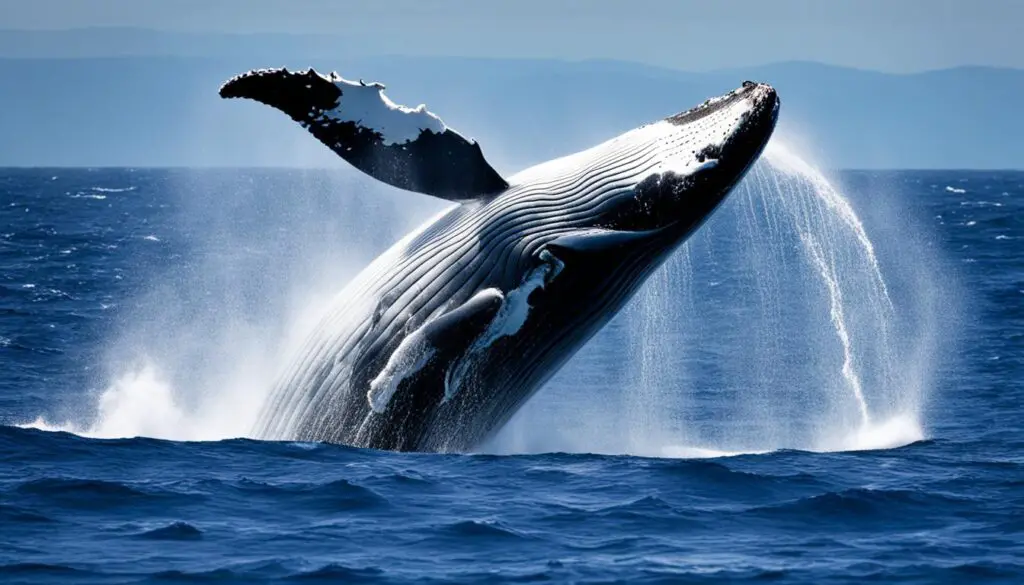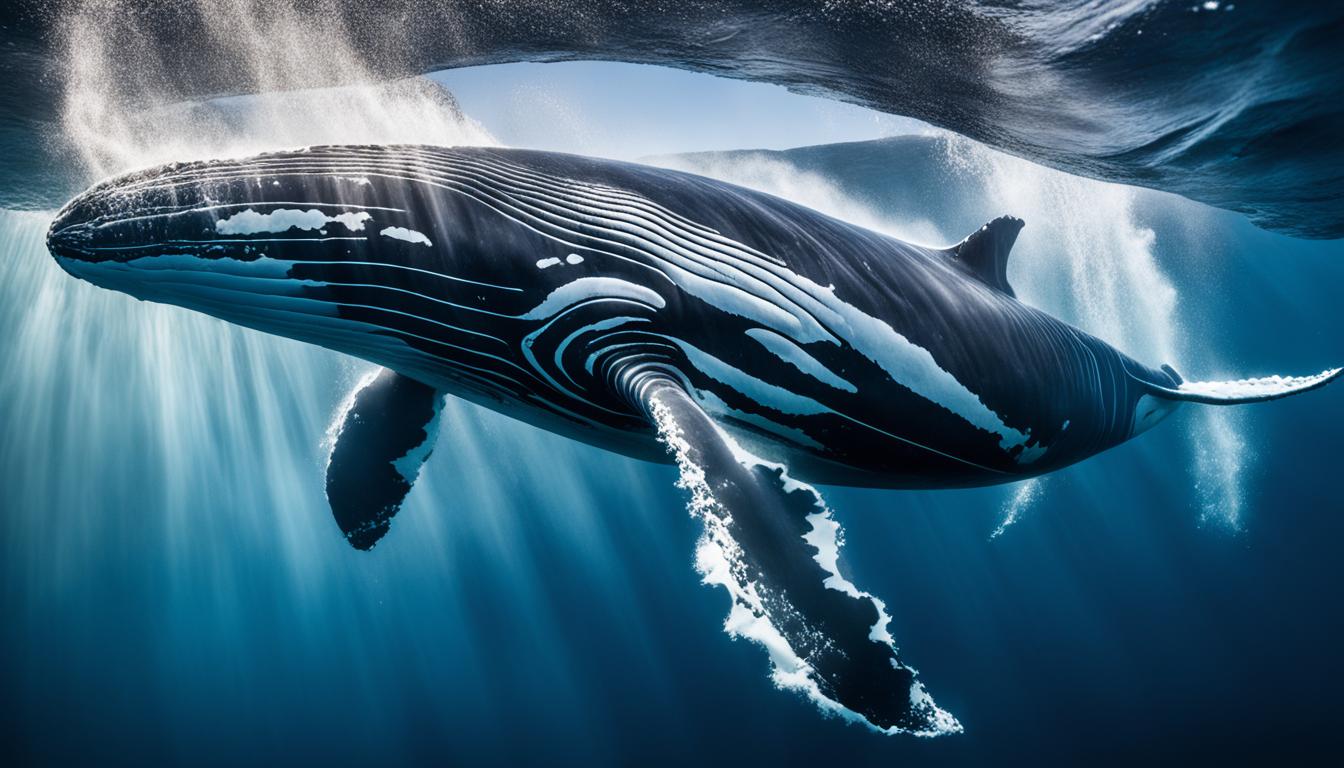Knowing how fast whales swim is key for marine biology and conservation. The speed of whales changes a lot between species. It’s also affected by many things in their environment.
By looking into whale swimming speed, we learn about their amazing skills. We also see how their speed affects their survival and the ocean’s health.
Introduction to Whale Swimming Speed
Learning about whale swimming speed helps us understand these amazing sea creatures better. The aquatic speed of whales changes a lot between species. It depends on where they live, how they act, and their body shape. Their ability to swim is key to how they live in the ocean.
Whales of different kinds swim at various speeds, showing their unique places in nature. For instance, the blue whale, the biggest animal on Earth, can swim fast. The top speed of whales like the orca is also impressive, helping them catch prey. These speeds are vital for their survival and finding food.
Studies show that whales change their swimming speed when they migrate or hunt. This shows they manage their energy based on their surroundings. It proves how important swimming is to their daily life and how they interact with their environment.
How Fast Can Whales Swim?
Learning about the speed of whales gives us a peek into their lives and how they interact with their world. Each whale type moves at its own pace, influenced by various factors. By looking at the swimming speeds of different whales, we see how these factors impact their speed.
General Swimming Speeds Among Whale Species
Whales swim at a wide range of speeds. Some cruise slowly, while others can zoom fast. The speeds vary a lot, as shown in the table below:
| Whale Species | Average Speed (km/h) | Top Speed (km/h) |
|---|---|---|
| Blue Whale | 5 | 20 |
| Humpback Whale | 5-10 | 15 |
| Killer Whale | 6 | 34 |
| North Atlantic Right Whale | 1.3 | up to 12 |
Factors Influencing Whale Swimming Speed
Many things affect how fast whales swim. The environment, like water temperature and currents, is key. Size and shape of the whale also matter. Behavior, such as hunting or avoiding predators, can change their speed too.
Top Speed of Different Whale Species
Exploring the swimming abilities of whales shows us how they adapt and behave in the ocean. The fastest whales can swim at amazing speeds, showing their skill in crossing vast waters. You’ll see big differences in how fast different whales swim, like the humpback whales.
Fastest Whales in Water
The orca, or killer whale, is the fastest whale, reaching speeds up to 34 mph (55 kph). The fin whale and blue whale can also swim very fast. These speeds help them avoid predators and catch food.
- Orca: 34 mph (55 kph)
- Fin Whale: 30 mph (48 kph)
- Blue Whale: 30 mph (48 kph)
Swimming Speed of Humpback Whales
Humpback whales swim at a pace of 3-9 mph (4.8-14 kph) usually. But they can go up to 15-16.5 mph (24-26.5 kph) when they need to. This lets them save energy but still be quick when needed.
Here’s how different whales compare in speed:
| Species | Average Speed (mph) | Max Speed (mph) |
|---|---|---|
| Orca | 28 | 34 |
| Fin Whale | 20 | 30 |
| Blue Whale | 15 | 30 |
| Humpback Whale | 3-9 | 15-16.5 |
Significance of Swimming Speed for Whales
Whales’ swimming speed is crucial for their survival. It helps them migrate to important places like breeding and feeding grounds. This speed lets them cover vast ocean distances efficiently.
Whales use their speed to find food. For example, blue whales swim fast to get to areas full of krill. This way, they balance their need for food with the energy needed for swimming.
Swimming speed affects how whales interact with each other. In groups like orcas, they swim together using coordinated patterns. This helps them stay safe and work together.
For mother and calf whales, speed is key. Calves need to keep up with their mothers to find food and stay safe. The mother’s speed can affect the calf’s survival, especially when facing dangers like ships or fishing gear.
Human actions are making it harder for whales to swim. Things like getting tangled in fishing gear, loud noises, and changes to their homes affect their swimming. This shows why we need to understand how whales swim and how we can help them.

Whale Movement Speed During Migration
Whales migrate to survive and reproduce. They face many challenges, like keeping a certain speed during migration. Knowing how fast they swim helps us see how the environment and humans affect them.
Migration Routes and Swimming Dynamics
Whales follow set migration paths. For example, humpback whales move at 3-9 mph (4.8-14 kph) on average. This speed helps them travel long distances and interact with other sea creatures and human-made objects.
Many things affect how whales swim during migration. These include water temperature, where they find food, and ocean currents. Knowing these helps protect whales from dangers like ship strikes and getting tangled in fishing gear.
| Whale Species | Average Migration Speed (mph) | Common Migration Routes |
|---|---|---|
| Humpback Whale | 3-9 | North Pacific, Atlantic Ocean |
| Gray Whale | 3-5 | Coastal North America |
| Blue Whale | 4-6 | Antarctic to Northern Pacific |
| Fin Whale | 4-8 | Global Migration Patterns |
Whales migrate with specific swimming needs. By studying their migration paths and speeds, we learn how they adapt to their environments and face threats. This knowledge is key to protecting these amazing sea creatures.
Impact of Human Activity on Whale Swimming Speed
Human actions in the ocean harm whale populations. Human impacts on whales can change their swimming speed. Noise from boats and physical barriers stress them out and change their swimming ways.
Studies show that anthropogenic factors affecting whale speed include less food and more competition for resources. Whales have to change their swimming to avoid boats, ships, and fishing gear. This can make it harder for them to find food or stay safe, affecting their health and survival.
Some whales change their migration paths and speeds to dodge busy sea areas. This can hurt their breeding and feeding. Saving whale species means protecting their homes and solving the problems humans cause for them.
Understanding Whale Velocity and Energy Expenditure
To understand how whales swim, we must look at their speed and energy use. The link between speed and energy use shows how whales move through their world. This helps us see how they survive and care for their young.
Different speeds affect how far and fast whales can go while saving energy. This is key for their survival, especially when they have babies.
Cost of Transport in Free-Ranging Whales
The cost of moving for whales tells us how efficient they are. It’s the energy they use to cover a certain distance. Studies on free whales show that faster whales use more energy. But, they can find the best speed to save energy in some situations.
| Whale Species | Average Speed (km/h) | Energy Expenditure (kJ/km) | Cost of Transport (COT) |
|---|---|---|---|
| Humpback Whale | 10 | 210 | 21.0 |
| Gray Whale | 5 | 150 | 30.0 |
| Sperm Whale | 7.5 | 180 | 24.0 |
| Fin Whale | 12 | 250 | 20.8 |
Slower whales often use less energy, which is better for long trips or finding food. This shows how important saving energy is for whales. It helps us understand their survival and how they move.
The Role of Mother-Calf Interaction in Swimming Behavior
Mother-calf interactions are key to the swimming skills of young whales. These interactions help young whales grow and learn how to swim. When you see whales in the wild, you might notice how a mother whale helps her calf swim. She guides her calf, teaching it to handle the challenges of the ocean.
Swimming is crucial for young whales during their early life. With their mothers, they learn to navigate and develop important skills. These skills help them avoid dangers and explore their world, which is vital for survival. Mothers also teach their calves how to rest while staying close, strengthening their bond.
Learning about these interactions helps us understand whale well-being. As humans threaten whales, it’s important to protect these relationships. Keeping these bonds safe helps whale calves and the whole species thrive.










